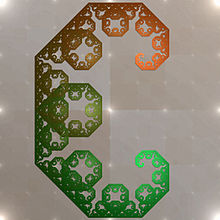Talk:Paul Lévy (mathematician)
| This article is rated Start-class on Wikipedia's content assessment scale. It is of interest to the following WikiProjects: | |||||||||||||||||||||||||||||||
| |||||||||||||||||||||||||||||||
Lévy dragon curve
[edit](Discussion copied from User talk:Solkoll and User talk:Gandalf61)
Saw your changes to Lévy C curve and Paul Pierre Lévy. Can you explain what your definition of the Lévy dragon curve is, and how it differs from the Lévy C curve ? The only references I can find to the Lévy dragon curve are actually about the Lévy C curve (see here for example). When people refer to a dragon curve without qualification, they always seem to mean the Harter-Heighway dragon curve, which I think has nothing to do with Paul Lévy. I don't mind removing the phrase "also known as the Lévy dragon curve" from the C curve article, but, as far as I know, there is not a separate curve called the Lévy dragon curve. Gandalf61 11:01, Feb 15, 2005 (UTC)
Hello Gandalf! About the Lévy curves: I'm not really sure where I read about the curves, (and maybe the source was wrong), it was some years ago now. But as far as I know there are three diffrent, closly related curves. At the moment I'm uploading images of IFS fractals I'm creating to "Commons". There I uploaded these three images the recent day or so, (doing this I also made some changes to the wikipedia articles about the curves, as you know =)
 |
 |
 |
Here you can see the diffrence between the "Harter-Heighways dragon curve" and the "Lévy dragon curve". Using IFS (random game), the construction of these curves are almost the same.
Lévy C curve:
- two points in a plane, (two "rules")
- scale factor; 1:sqrt(2) for both rules
- rotation angles; rule [0] = 45º, rule[1] = -45º
Lévy dragon curve:
- two points in a plane
- scale factor; 1:sqrt(2) for both rules
- rotation angle; 45º for both rules
Harter-Heighways dragon curve:
- two points in a plane
- scale factors; rule [0] = 1:sqrt(2), rule [1] = -1:sqrt(2)
- rotation angles; rule [0] = 45º, rule[1] = -45º
I'm not 100% sure I got it all correct, but it's close =)
I hope this helped you a bit? If I can find some kind of source for this information, then I get back to you. // Solkoll 17:09, 15 Feb 2005 (UTC)
- Thank you for your response on my talk page, and for the illustrations. I have re-read Lévy's original paper "Plane or Space Curves and Surfaces Consisting of Parts Similar to the Whole", and I cannot find any mention of the curve that you are calling the Lévy dragon curve. Lévy presents various general results that apply to any self-similar curve, but the only two 2-D curves that he discusses in detail are the Koch curve and the curve that he refers to as , which we call the Lévy C curve. All his figures show the Lévy C curve. In the copy I have, which is in Gerald Edgar's anthology "Classics on Fractals", Edgar adds commentary in which he refers to Lévy's curve as the Lévy dragon curve, which is another reason why I thought this was just another name for the Lévy C curve. Can you provide any reference that links your Lévy dragon curve to Lévy, or that calls it the Lévy dragon curve ? Gandalf61 11:07, Feb 16, 2005 (UTC)
- In the absence of any evidence that Solkoll's Lévy dragon curve has any link to Paul Lévy, I have removed the reference to it from the article. Gandalf61 11:09, Feb 21, 2005 (UTC)
- Start-Class biography articles
- Start-Class biography (science and academia) articles
- Unknown-importance biography (science and academia) articles
- Science and academia work group articles
- WikiProject Biography articles
- Start-Class mathematics articles
- Mid-priority mathematics articles
- Start-Class France articles
- Low-importance France articles
- All WikiProject France pages




